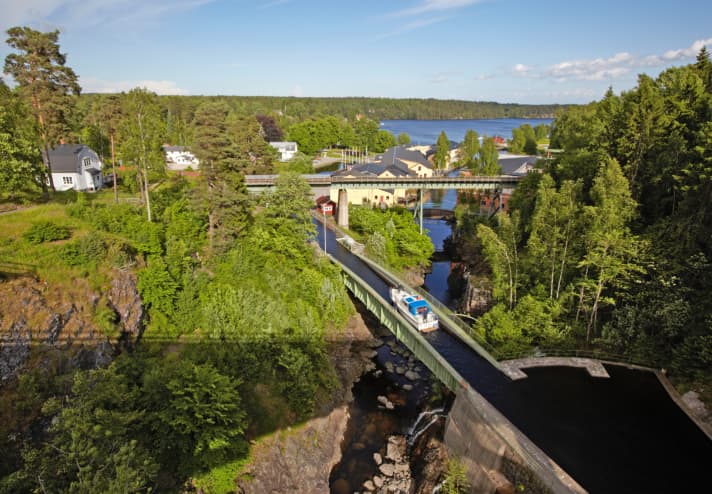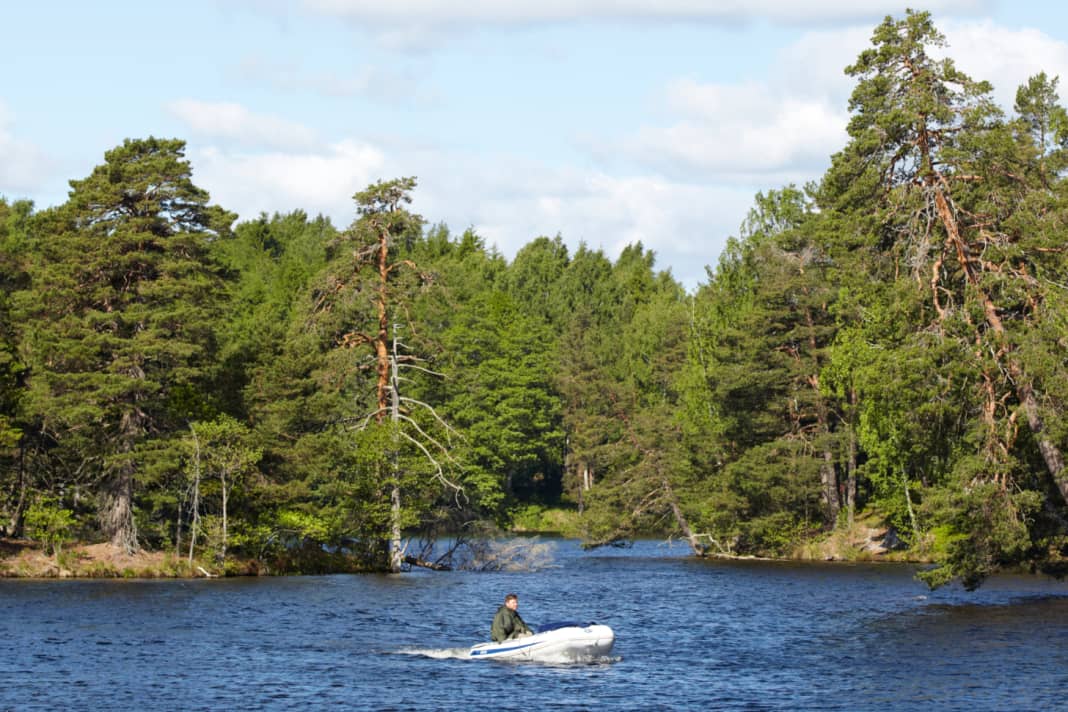







And it was here that the king almost fell into the canal if his wife hadn't held him," Bo tells us. A ray of sunlight in the narrow gorge had blinded Carl XV - and a careless step backwards almost sent him over the railing of the saloon boat "Laxen" into the water. "That would have been a real canal baptism," Bo remarks laconically. "What a wet end to that glorious day".
That day was 19 September 1868: after five years of hard work, the Dalsland Canal had been completed. It had been cleared, dug and blasted to connect the vast lakes in the wooded south-west of Sweden and create a navigable link to Lake Vänern. It was the first transport route ever to lead into the wilderness, which was poor in people but rich in timber and ore.
Rapids and a waterfall
It almost came to nothing, as there was one spot in particular that gave the engineer in charge, Nils Ericson, a headache: Lake Åklang flowed into Upperudshöljen near the small village of Håverud - and this was precisely the route the new waterway had to take. Although the difference in level was only nine metres, the gorge was narrow and steep, with rapids and a waterfall. The loose rock ruled out a conventional lock staircase as a solution.
Then Ericson had a brilliant idea: instead of using the gorge itself, he would simply "walk over" it - with an aqueduct. Four adjoining lock chambers in solid ground could then be used for the descent. But that was easier said than done: the 32.5 metre long, self-supporting trough bridge made of prefabricated steel elements could only be assembled on site and painstakingly hoisted into place. 33,000 rivets still hold it together today. All in all, a technical masterpiece of the highest calibre. After all, not even the famous Göta Canal can boast anything comparable...
Barely a sheet of paper fits between the fuselage and the trough wall
We are now standing and waiting just a few metres from the start of the aqueduct. Opposite, on the rock face, a plaque commemorates the opening of the canal almost 150 years ago in the presence of the king. "Maybe I'll take a quick dip," says Bo, feigning a jump.
But then the "Dalslandia" finally emerges from the uppermost lock and glides over the abyss full of marvelling excursionists. Barely a sheet of paper fits between the hull and the trough walls, the steel channel of the aqueduct is so narrow. Flashing lights illuminate the shadows of the gorge.
We slowly walk with Bo back to the waiting jetty, where his sea kayak and our dinghy are moored. A somewhat outdated spitsail with a Norwegian flag has joined us. The relaxed owner in the open cockpit greets us in a friendly manner with his whistle, while his border terrier eyes us keenly from the foredeck.
"Here to recharge too?"
We have a few minutes left to chat. Bo, we already know, is an IT administrator at the University of Umeå, quite far north. He comes to Dalsland once a year to paddle and "recharge his batteries", as he says. Tobias, who is Norwegian, has come down from Otteid, where the network of waterways extends into the neighbouring country. "Here to 'recharge' too?" we ask. Tobias takes a puff on his pipe and says seriously: "Yes, the air is very good." "Nonsense," interjects Bo, grinning. "The air is the same as yours. The beer is just cheaper!" The Norwegian doesn't answer, but the telltale twitch around the corners of his mouth speaks volumes.
Now a wiry blonde from theslussvakt The lock personnel approach and give us the longed-for starting signal. Ericson's stroke of genius awaits! "Don't go overboard," shouts Bo as he joins the back of the boat.
Our journey through the historic province began around a week ago in Ed, at the southern end of the elongated Lake Stora Le, not far from where Tobias started. It is the beginning of June. We actually spend the first night in our tent on Norwegian soil, on the pebble beach of a small island (see BOOTE 8/2014). We then continue northwards, first to Töcksfors, where we even have to wait for the official start of the season the next day before our first lock. Instead, we are the first boat to carefully push our way through the carpet of water lilies between the two chambers.
Norway is just one kilometre away
From Töcken northwards, our path leads through a narrow passage in the dense forest. The almost overgrown skeletons of old bridges loom on the banks. The dark water is still and covered in yellow pollen, nature is beautiful. We are completely alone when we moor up for a picnic on a deserted jetty at Strömmesjön and later head out onto Östen, the northernmost lake in the area, under the first shy rays of sunshine.
Norway is only a kilometre away from the jetty in Östervallskog - and on our short walk along the country road, there is no sign of the Riksgränse apart from an inconspicuous sign. Relaxed neighbourhood!
As we explore the northern shore of the Östen, we actually hit the only rock in the entire northern half of the lake before Grundsön. But we are lucky: apart from a small gash in the propeller blade, nothing has happened. We pitch our tent on the smooth rock of a peninsula that is inaccessible from land. Skellbredhöjden is the name of the spot on our map. We secure our Grand Corvette C 360 to two trees with shore lines. In the evening, the lake becomes a blue mirror. A beautiful place in absolute solitude. Even the only holiday home, far away on the opposite side, seems to be uninhabited. Once again, we look for a hollow filled with earth for our fire until a dark cloud extinguishes the flames with a shower at midnight and drives us into our sleeping bags.
We improvise a fridge
Summer is now here and we have the sun on our faces on our way to Lake Vänern! We stop off again in Töcksfors, where the modern shopping centre has its own jetty: We buy ice cubes in bags to convert one of our plastic bins into an improvised fridge, and two canisters of petrol from the roadside petrol station for our trusty two-stroke Yamaha fifteen-stroke.
With no wind at all, our wake runs dead straight across Lake Foxen. Feathery clouds adorn the sky. It is now very hot and we spend our break floating and dozing. The water is tempting, but even colder than expected.
We moor up at the nature campsite in Lennartsfors to explore the town. It looks deserted in the sweltering midday heat. There are no more shops; the country store and petrol station have closed down. Behind dusty windows, we can still see piles of supplies in the semi-darkness.
Sweating, we return to the boat. We use an intercom system to report to the lock stairs. Here, the entire upper access channel has been blasted out of the mountain. We follow the orange-coloured sign with the word Sluss until we reach the first gate. There are three chambers of bare rock to pass through. Vertical, peeled tree trunks protect us from the sharp edges. Clear groundwater runs out of cracks and crevices.
Drizzle accompanies us to Bengtsfors
Another night on a deserted island, this time at the northern tip of Bråtnäsön on the Lelång. A small bay is perfect for our dinghy. We find wood in the forest and cook our noodles directly on the coals as we have run out of gas. Then we stretch out on the warm rocks until the clouds come.
In the morning, drizzle accompanies us to the small town of Bengtsfors. We quickly tie up the boat in the guest harbour before treating ourselves to hot coffee and homemade chocolate cake in "Kickis Café" on Storgatan. We get the tip about the campsite on the neighbouring lake Ärtingen (which is reached via a barely visible passage under a road) from the tourist information office. Luckily, we pitch the tent on higher ground, because it's really raining. We stay here for two days; at least the showers are wonderfully hot.
A bet that has already been won
On the third day we finally continue. Under a grey sky, but at least it's dry. Lupins glow white and blue in the twilight, bright green ferns arch along the banks. Via locks 18, 19 and 20, which lie in complete seclusion in the forest, we reach Billingsfors, Laxsjön and Råvarp. We continue down barrage after barrage and the sun has long since come out when we moor at the waiting jetty in front of the Håverud aqueduct. A kayaker is already waiting there: Bo.
In the evening, when the day trippers have long since disappeared and the three of us are sitting by the canal, exchanging experiences and our adventure across Dalsland is almost over - Köpmannebro and the mighty Vänern are only a few kilometres away - the Swede surprises us with an unexpected remark: "Bet you couldn't write anything bad about this beautiful place?" He sees our astonished faces. "I know," he adds with a knowing look and looks across the lake to the south. "I couldn't either".
TERRITORY INFORMATION
The precinct
The Dalsland Canal was opened in 1868 and, until the construction of a railway line towards the end of the century, was mainly used to transport saw timber and iron ore to Lake Vänern and on to the North Sea and Baltic Sea. With its tributaries, it comprises around 400 km of waterways, the main route runs over 140 km from Ed via Bengtsfors and Håverud to Köpmannebro (or Köpmannehamn) and overcomes a height difference of 58 metres with 23 locks. In Dals Langed and Håverud, four chambers are combined to form lock stairs.
The minimum depth of the fairway is 1.80 metres. Difficult places are marked with cardinal or lateral bars. The lowest clearance height is 3.60 metres (bridge in Töcksfors). Navigation is unproblematic with the appropriate maps. The infrastructure for boats is good throughout, with supply facilities available in all the larger towns. There are boat refuelling stations in Ed, Töcksfors, Bengtsfors and Köpmannebro. Mooring is generally Scandinavian, i.e. with the bow at the jetty and a mooring ring at the stern.
The channel
In 2014, the season on the Dalsland Canal lasted from 9 June to 24 August; the dates for 2015 had not yet been finalised at the time of going to press, but will be within a similar time frame. The core operating hours at the locks are from 9 am to 7 pm and 10 am to 4 pm (Sundays), occasionally longer. The cost of using the canal depends on the size of the boat and the number of locks: for a boat between 5.00 and 7.99 metres in length, each lock chamber costs 85 Swedish kronor (approx. 9.30 euros), while a return ticket for the entire canal costs 2500 kronor (approx. 270 euros). Further information: www.dalslandskanal.se
The journey
The distance from Kiel to the start of the canal at Vänern is around 400 nm (740 km) by water, including the Trollhättan Canal. If you have time, you can also include the Dalsland Canal as a detour on a trip via the Göta Canal. For skippers with a car and trailer, the route via Denmark and southern Sweden is around 740 km from Lübeck and around 680 km from Rostock. Slipways and parking spaces are available in all larger towns.
Charter
On the Dalsland Canal, the operating company offers a Nimbus 2600 stationed in Köpmannebro. The 8.45 metre long cabin cruiser has two cabins with two berths each and an additional berth in the saloon. Weekly prices range from SEK 10,000 (1100 euros) to SEK 14,995 (1640 euros). An official pleasure craft licence is required as proof of competence. Contact: Dalslands Kanal AB, Nils Ericsons väg 1, Upperud, SE-46472 Håverud. Tel. 0046-530-447 50. www.dalslandskanal.se

